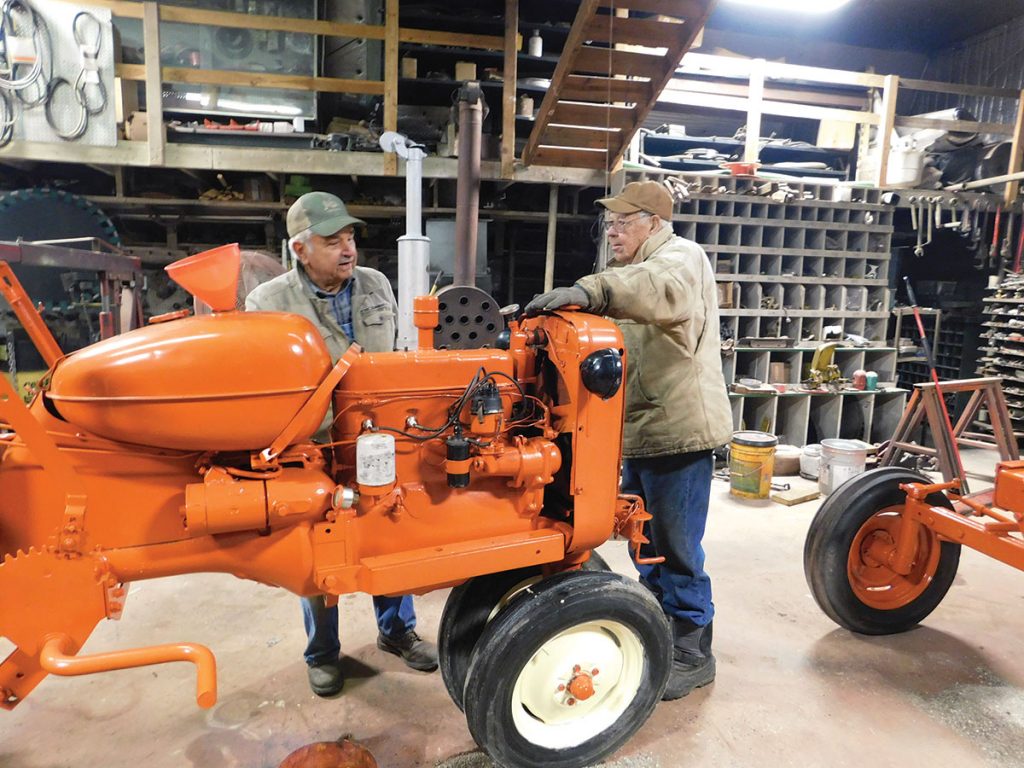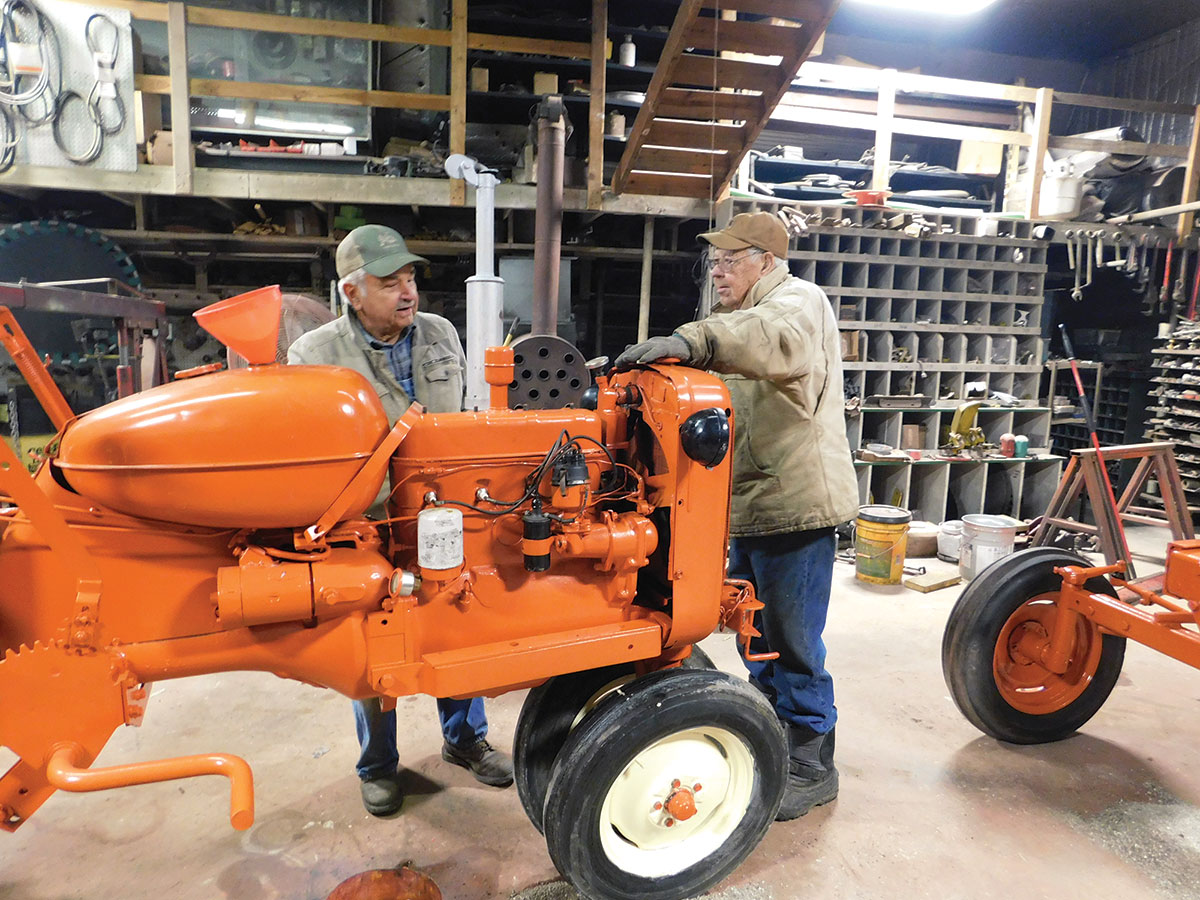
Retired farmers now work on tractors as a hobby, not as a necessity
What do old farmers who love tractors do when they retire? They start looking in fence rows, barns and go to auctions.
Even a wreck of a tractor sitting in someone’s barn lot is cause for a squealing of the brakes and a bit of bartering. They drag the relics home to their shops and give the old tractors new life.
Gilbert Willson, of rural Nevada, Mo., started driving a tractor when he was 6. He had to stretch to reach the brake and clutch. He couldn’t reach the rope to trip the plow and drive, so his older sister, Ruby, who was 10, rode on a ledge on the back of the tractor and tripped the plow when they turned.
R. L. Willson, Gilbert’s father, could do anything with horses, but Gilbert said he could do nothing with tractors.
“He hardly knew where to put a wrench,” Gilbert said. “I mostly learned to work on them on my own. But my Grandfather Kessler had a blacksmith shop at Bristol and I must have gotten some mechanical genes from him.”
Gilbert began working on a W.D. Allis Chalmers and an M Farmall for his dad.
“I worked on it a lot,” he recalled. “All they hardly ever needed was some points, plugs, a tune-up once in a while. I like the old tractors. They are simple. I have no interest in the new ones. They won’t be around in 40 years. There are too many electronic things on them. The old ones will be around forever.”
Gilbert got married and he and his wife Eleanor bought their first tractor, a used Allis Chalmers D17 diesel from P & B (Peterson and Balk) tractor in Nevada in 1960.
In 1969, they bought their first new tractor, an Allis Chalmers 190XT.
“I probably learned the most about working on tractors from Vernon Balk and Herschel Culbertson, both mechanics at P & B,” Gilbert said. “They were really good to show you how to fix stuff. I learned a lot from them.”
After farming most of his life and raising his family, Gilbert decided to retire from the actual labor, but remain on the farm. That way he still has access to his shop and tools.
“I can’t just sit around,” he added. “This gives me something to do. I like to play around with them.”
When Gilbert isn’t working on an old tractor, he likes to go tractor museums. He discovered one south of Pittsburg, Kan., when he was looking for an engine. The man took him to a big shed, probably 200-by-100 feet.
“It was full of redone tractors from F20s to 4-wheel drives,” Gilbert said.
He also visited the museum at the College of the Ozarks and been to the Farm and Auto Museum in Branson, Mo., three times.
“I like to go through there as they buy and sell and you can see changes all the time,” he said.
Gilbert is a meticulous mechanic. When he gets done, everything is practically perfect. His comment about the tractors in the museums was, “I wouldn’t trade my paint job for any of them except one. It shone and no marks or creases.”
Gilbert’s first tractor he restored is a International 666 purchased new in 1972 by J. T. Jeans from Floyd Phillips at Schell City. J.T. has since passed away and his son, Wayne, discovered it rusting in a fence row. He loaded it up and brought it to Gilbert.
The second tractor he has redone is an Allis Chalmers WD45 he purchased at an auction.
He has two more waiting in his shed: a John Deere 630, and another WD45 Allis. After that, he has an Allis Chalmers round baler, like the one he has baled hundreds of bales of hay with, he plans to redo.
When Gilbert isn’t working on his own tractors or traveling to museums, he likes to help his neighbor, Charles Foreman, work on his old tractors and do the finish work of painting.
Charles is also a retired farmer and a rural mail carrier. He began working for his uncle, Roscoe Hamilton, when he was 16, running an F12 Farmall International made sometime in the 1930s.
The 1950s brought a side trip to Korea, marriage and family. He was able to buy his first new tractor at P & B Equipment in Nevada in 1960. It was a Allis Chalmers D17.
If he wasn’t working on his mail truck, Charles was fixing a tractor through the years to farm with. He said, “You had to learn to repair the equipment to survive,” and he learned how.
“In the field of hard knocks – usually on my knuckles,” Charles said.
Now, he enjoys restoring tractors. In the past two years, with Gilbert’s help, he has restored a Allis Chalmers D17 and a Allis Chalmers CA. Charles and Gilbert spend a lot of enjoyable time in one of their shops or the other. They don’t plan on rusting out, or let any tractor they can get their hands on do it either.







